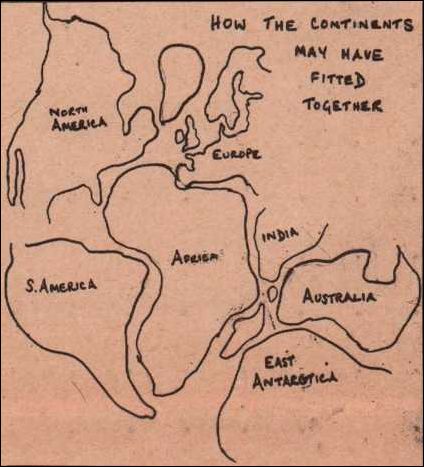
Main NI Index | Main Newspaper Index
Encyclopedia of Trotskyism | Marxists’ Internet Archive
From Socialist Worker, No. 86, August 1969, p. 2.
Transcribed & marked up by Einde O’Callaghan for ETOL.
CAN ANYTHING BE IMAGINED that is more stable than a whole continent? The idea that such great masses of land could move seems absurd at first, but it is almost certainly true that the continents were at one time grouped together and have since drifted apart.

|
If you look at a map you can see that North and South America fit into Europe and Africa almost like pieces of a jigsaw puzzle. The fit is very good indeed if you try the fit, not at the shore line, but at the edge of the continental shelf, where the shallow sea floor suddenly plunges to the full depth of the ocean floor. The fit is so good that it could not be just a coincidence.
And various ancient mountain chains and folds in the rocks correspond in every respect in parts of Africa and South America. The rocks are very similar in the older parts of the two continents and also similar to rocks in India, Australia, and the Antarctic. Study of the strata and fossils in the rocks shows that they had a closely similar geological history.
Some fossils have a distribution that can only be explained on the basis of continental drift. A small reptile called Mesosaurus is found only in parts of Africa and South America. The separate parts of its range may be brought together by regrouping the continents in their best-fit position. Coal deposits found in the Antarctic suggest that the climate was once tropical or subtropical, which could be explained by that continent having once occupied a position near the equator.
When an iron-bearing rock is formed, either by solidification of molten volcanic lava, or by precipitation from solution, it becomes slightly magnetised in the direction of the earth’s magnetic field. Such rocks act as a sort of frozen compass needle, pointing towards where the North Pole was at the time they were formed.
The North Pole seems to move relative to any one continent over long periods of time. But the Pole seems to be moving differently for different continents, and since there is only one North Pole which can only be in one place at a time, we are forced to conclude that it is the continents that are moving.
What makes the continents move? Nobody knows the answer to this. But it is likely that the escape of heat from the centre of the earth sets up very slow movements in the rocks underlying the earth’s crust.
These rocks are not solid – they are very hot and form a very dense treacly liquid. The continents are made of lighter rock and float on top. The movements in the earth produce areas where rock from the interior is being pushed up to the surface – the ridge in the middle of the Atlantic is an example – and areas where rocks are being drawn into the centre – such as the deep trench near Japan.
It is thought that upflows could push the continents apart. In this way the Atlantic ocean could have been formed by a split in an originally much larger continent.
Main Socialist Worker Index | Main Newspaper Index
Encyclopedia of Trotskyism | Marxists’ Internet Archive
Last updated on 30 October 2020